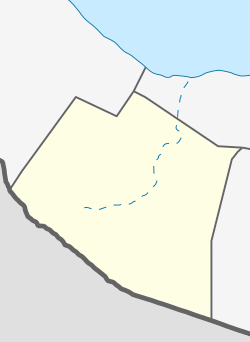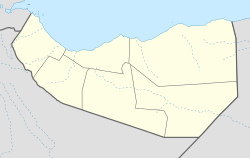This is an old revision of this page, as edited by Abdihakimper (talk | contribs) at 12:01, 23 December 2023. The present address (URL) is a permanent link to this revision, which may differ significantly from the current revision.
Revision as of 12:01, 23 December 2023 by Abdihakimper (talk | contribs)(diff) ← Previous revision | Latest revision (diff) | Newer revision → (diff) City in Somaliland| Gabiley
Gabiley (Somali) غابيلي (Arabic) | |
|---|---|
| City | |
  Gebiley National Library Gebiley National Library | |
 Seal Seal | |
  | |
| Coordinates: 9°42′0″N 43°37′25″E / 9.70000°N 43.62361°E / 9.70000; 43.62361 | |
| Country | |
| Region | Maroodi Jeex |
| District | Gabiley |
| Government | |
| • Mayor | Mahamed-Amin Omar Abdi |
| Population | |
| • Total | 106,914 |
| Time zone | UTC+3 (EAT) |
Gabiley (Template:Lang-so, Template:Lang-ar), also known as Gebiley, is a city in the Maroodi Jeex region of Somaliland.
Gabiley is located 58 km west of Hargeisa, the capital of Somaliland. It is in the center of the Gabiley district, bounded on the north by the Gulf of Aden, on the west by the Awdal region, on the east by the Hargeisa district, and on the south by the Somali Region of Ethiopia.
History
Gabiley is one of the oldest towns in Somaliland after Zeila, Berbera and Amud. Some stones left behind in the area were believed to have been earmarked for the construction of pyramids. For example Dhagax Gurre situated around 45km northeast of Gabiley and lies about two Hours drive from Hargeisa the paintings are more than 5000 years old.
It comprises several individual painted shelters scattered on a rocky hill. The main shelter has an inclined ceiling which is decorated with an assemblage of bovid figures as well as one giraffe and one anthropomorphic figure. The second most important shelter, which lies at the base of the granite outcrop, is adorned with panels representing sheep (or goats) and a few human figures holding a bow. The colours and the complexity of the paintings are much less striking than those at Las Geel, but they’re interesting nonetheless.
Demographics
The town of Gabiley has a population of around 106,914.
The Gabiley District in which the city is situated is exclusively dominated by people from the Somali ethnic group, with the Jibril Abokor and Abdalla Abokor sub divisions of the Sa'ad Musa subclan of the Habar Awal Isaaq and the Gadabuursi subclan of the Dir who inhabit the entire western section of Gabiley.
Education
Primary schools, Secondary schools and University education is available throughout the district. The smaller communities have their own primary schools. For post-secondary education, Timacade University was opened in 1999 to serve the needs of the town's students. The education system in Gabiley region is growing in a faster pace than most of Somaliland. Gabiley district has many secondary Schools such as Qalax Secondary, Cigaal Schools, and Al-Irshaad Secondary.The Primary schools are booming too and after the civil war in 1991 ended and Somaliland's education system settled down, this progressive town enjoys having many primary schools notably Sheikh Muxumed Warsame , Imaamu Shaafici Primary School and others. Gebiley National Library opened in April 2021 to give the suitable space that all students can go and read the numerous textbooks available.
Healthcare
Gabiley has 6 operating general hospitals. One massive hospital opened in 2010, it provides medical services to the larger region. Gabiley is considered one of the medium-sized district that has a very sufficient medical spacious centers that the population of Gabiley benefits from them and the sustainability of ongoing small private hospitals and clinics have been growing for the last two decades.
In 2016 the municipal government was led by Mahamed-Amiin Omer Abdi who is the current mayor of Gabiley city and the governor of Gabiley region.
Agriculture

Gabiley is the main farm land for Somaliland and produces up to 85% of Somaliland's food supplies. It is known for its agricultural and farming industry, and is where most of Somaliland's crops are produced. Crops grown in the area include apples, oranges, bananas, corn, pears, maize, wheat, barley, beans, lemon, peas, groundnuts, potatoes, tomatoes, onions, garlic, salad and cabbages, broccoli, watermelon, papaya and many other types of fruits and vegetables. Gabiley is considered to be the most fertile region in Somaliland.
Climate
According to Köppen-Geiger system, Gabiley has a hot semi-arid climate (BSh), although it is moderated by altitude. The average annual temperature is 21.4 °C or 70.5 °F, and the average annual rainfall 489 millimetres or 19.25 inches. June is the hottest month of the year with an average of 24.5 °C or 76.1 °F, whilst January is the coolest with an average of 17.6 °C or 63.7 °F. The driest month is December, with 2 millimetres or 0.079 inches of rain, and the wettest August with 91 millimetres or 3.58 inches. There is a difference of 89 millimetres or 3.50 inches of rainfall between the driest and wettest months. The variation in annual temperature is around 6.9 °C or 12.4 °F.
| Climate data for Gabiley | |||||||||||||
|---|---|---|---|---|---|---|---|---|---|---|---|---|---|
| Month | Jan | Feb | Mar | Apr | May | Jun | Jul | Aug | Sep | Oct | Nov | Dec | Year |
| Mean daily maximum °C (°F) | 24.6 (76.3) |
26.1 (79.0) |
28.1 (82.6) |
28.6 (83.5) |
29.9 (85.8) |
30.7 (87.3) |
29.2 (84.6) |
29.2 (84.6) |
29.9 (85.8) |
27.9 (82.2) |
26 (79) |
24.2 (75.6) |
27.9 (82.2) |
| Mean daily minimum °C (°F) | 10.6 (51.1) |
12.2 (54.0) |
14.4 (57.9) |
16.2 (61.2) |
17.4 (63.3) |
18.3 (64.9) |
17.8 (64.0) |
17.6 (63.7) |
17.4 (63.3) |
14.4 (57.9) |
12.2 (54.0) |
11.2 (52.2) |
15.0 (59.0) |
| Average rainfall mm (inches) | 4 (0.2) |
11 (0.4) |
33 (1.3) |
74 (2.9) |
63 (2.5) |
36 (1.4) |
73 (2.9) |
91 (3.6) |
76 (3.0) |
18 (0.7) |
8 (0.3) |
2 (0.1) |
489 (19.3) |
| Source: Climate-Data.org, altitude: 1,460 metres or 4,790 feet | |||||||||||||
Notable residents
- Abdillahi Suldaan Mohammed Timacade, prominent Somali poet during the pre- and post-colonial period from Galooley who conducted public readings in the area. He belongs to the Ali Jibril (Reer Hareed) sub-clan of the Jibril Abokor clan.
- Mohamed Hasan Abdullahi, former Chief of Staff of Somaliland Armed Forces and SNM General. He belongs to the Ali Jibril (Reer Dalal) sub-clan of the Jibril Abokor clan.
- Mo Farah, British four-time Olympic gold medalist and the most decorated athlete in British athletics history; belongs to the Muhammed Jibril (Deriyahan) sub-clan of the Jibril Abokor clan.
- Nuh Ismail Tani, current Chief of Staff of Somaliland Armed Forces. He belongs to the Ali Jibril (Reer Hareed) of the Jibril Abokor clan.
- John Drysdale, also known as Abbas Idriss, a British-born army officer, diplomat, writer, historian, publisher, and businessman who spent the last years of his life in the city. Most notably, due to his expertise on Somali history and culture, he served as an advisor to UNOSOM II and advocated for a diplomatic resolution to the war raging between UNOSOM II and Mohammed Farah Aidid in 1993. He was also the first ever Caucasian to vote in Somaliland elections.
References
- ^ "Population Estimation Survey 2014 For the 18 Prewar regions of Somalia" (PDF).
- "Issue 270". Retrieved 28 March 2016.
- "The Transitional Federal Charter of the Somali Republic" (PDF). University of Pretoria. 1 February 2004. Archived from the original (PDF) on 25 March 2009. Retrieved 2 February 2010.
- Somalia Recent Economic and Political Developments Handbook Volume 1 Strategic Information and Developments. May 2007. ISBN 9781433062568.
- Districts of Somalia, Statoids
- The Archaeology of Islam in Sub Saharan Africa, p. 72/73
- Marchal, Roland (1997). Studies on governance. United Nations Development Office for Somalia. p. Awdal region Page 9.
- "Refworld | Somalia: Information on the ethnic composition in Gabiley (Gebiley) in 1987-1988".
- Phillips, Sarah. "Political Settlements and State Formation: The Case of Somalia" (PDF). Archived from the original (PDF) on 2 February 2017. Retrieved 4 June 2017.
- Sommerlatte, Malte (2000). Ecological Assessment of the Coastal Plains of North Western Somalia (Somaliland). IUCN Eastern Africa Regional Office. p. 4.
The Issa Musa are the more coastal sub-clan of the Habr Awal, and they live in the immediate environs of Berbera and extend southwards to Hargeisa. West of them but in proximity are the Sa'ad Musa, who extend from a narrow strip on the coast near Bullaxaar and El Sheikh towards the towns of Gebile and Hargeisa which they dominate, and across into their grazing lands in the rich plateau area of the 'Haud' in Ethiopia.
- "My volunteer experience at Hargeisa School of Social Work, University of Hargeisa. |". Archived from the original on 2018-08-12. Retrieved 2018-04-14.
- "Assessment in Awdal Region, Somaliland 11th to 15th Dec 2016 - Somalia".
- "Climate: Gabiley - Climate graph, Temperature graph, Climate table". Climate-Data.org. Retrieved 25 September 2013.
- "Mo Farah's family cheers him on from Somaliland village". The Guardian. 10 August 2012. Retrieved 13 March 2014.
External links
- Gabiley news (Somali)
- Gabiley - coordinates